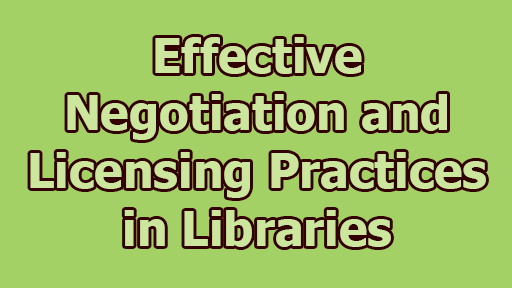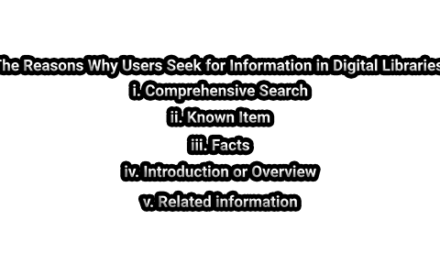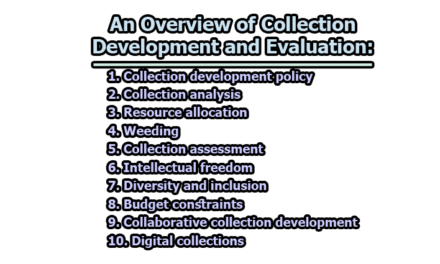Effective Negotiation and Licensing Practices in Libraries:
Negotiation and licensing play a significant role in various contexts, from business agreements to intellectual property rights. In the context of libraries, information institutions, and digital resources, negotiation and licensing are crucial for securing access to resources, managing collections, and complying with legal and contractual obligations. Here’s an overview of effective negotiation and licensing practices in libraries:
Negotiation: Negotiation involves the process of discussing and reaching mutually acceptable terms, conditions, and agreements between two or more parties. In the context of libraries and information institutions, negotiation is essential for acquiring and managing various resources, including print and digital materials, licenses for electronic databases, and services from vendors or publishers. Here are some key aspects of negotiation in libraries:
1. Resource Acquisition: Libraries aim to build and maintain comprehensive collections that meet the needs of their patrons. To do so, librarians negotiate with vendors, publishers, and content providers to acquire a wide range of materials, including books, journals, e-resources, and multimedia content. Negotiations in resource acquisition involve several key aspects:
- Pricing: Librarians negotiate pricing terms to obtain resources at reasonable costs. This may include negotiating for discounts, especially for bulk purchases, multi-year agreements, or consortium-based acquisitions.
- Licensing Terms: Negotiations cover the terms and conditions under which materials will be acquired. Licensing agreements specify the rights, access models (e.g., perpetual access, subscription-based access), and restrictions associated with the content.
- Content Packages: Librarians may negotiate for customized content packages tailored to the specific needs of their institution, ensuring that the collection aligns with the curriculum and research interests of their users.
2. License Negotiation: Electronic resources such as e-journals, databases, and e-books are essential components of modern library collections. License negotiation for these resources is a complex process that involves several considerations:
- Terms of Access: Libraries negotiate for access terms that define who can use the resource, whether it’s available on-campus or remotely, and under what conditions.
- Usage Restrictions: Negotiations address any restrictions on the use of electronic resources, including limitations on downloading, printing, or sharing content.
- Pricing and Renewal: Libraries strive to secure favorable pricing structures and renewal options, aiming to balance the cost of access with budget constraints. Negotiations may also include discussions on price escalation over time.
- Cancellation Terms: Libraries must consider the terms and conditions for canceling licenses, ensuring flexibility to adapt to changing collection needs.
3. Content Access: Negotiations regarding content access are crucial to ensure that authorized users, such as students, faculty, and researchers, can easily access and utilize digital resources. This involves negotiating for seamless and user-friendly access methods, such as Single Sign-On (SSO) integration or proxy server setups.
4. Pricing and Cost Management: Managing a library’s budget is a constant challenge, and negotiations play a central role in cost management. Librarians explore various strategies to obtain cost-effective access to resources:
- Volume Discounts: Negotiating volume discounts for high-demand resources can significantly reduce costs.
- Consortium Pricing: Collaboration with other institutions in consortiums can lead to collective bargaining power, resulting in better pricing for shared resources.
- Annual Subscription Costs: Libraries engage in negotiations to ensure that annual subscription fees align with their budgetary constraints.
5. Usage Rights: Usage rights negotiations are essential to determine how patrons can utilize digital resources. This includes negotiating terms related to the number of simultaneous users allowed, interlibrary loan privileges, remote access options, and document delivery services. These terms directly impact the user experience and the library’s ability to serve its community.
6. Contractual Agreements: Finally, librarians engage in negotiations to draft and finalize contractual agreements with vendors and content providers. These agreements must align with the library’s specific needs, policies, and strategic objectives. Negotiating favorable terms and ensuring clarity in contracts is critical to avoid misunderstandings and disputes in the future.
Licensing: Licensing involves formalizing and documenting the rights and permissions granted by content providers to libraries, institutions, or individuals. Licensing agreements outline the terms and conditions under which resources can be accessed, used, and shared. In the context of libraries and information institutions, licensing is prevalent for electronic resources and digital content. Here’s more on licensing in libraries:
1. Electronic Resource Licensing: Electronic resource licensing is a critical practice in modern libraries, allowing them to provide access to a wide array of digital materials. These materials may encompass scholarly journals, databases, e-books, multimedia resources, software tools, and more. Libraries typically enter into licensing agreements with publishers, content providers, and vendors to gain permission to access and distribute these digital resources to their patrons.
2. Terms and Conditions: Licensing agreements serve as legally binding documents that outline specific terms and conditions governing the use of electronic resources. These terms include:
- Subscription Duration: The agreement specifies the duration for which the library is licensed to use the resource. This can range from annual subscriptions to multi-year licenses or even perpetual access in some cases.
- Permitted Use: Licensing agreements dictate how the resource can be used. For instance, they may specify the number of simultaneous users, downloading limitations, printing restrictions, and whether interlibrary loan requests are allowed.
- Access Methods: The agreement details the methods by which authorized users can access the resource. This may include on-campus access, remote access via secure authentication methods, or access through proxy servers.
- Renewal Options: Licensing agreements provide information on how libraries can renew the license when the initial term expires. Renewals may involve discussions on potential changes to terms and pricing.
- Pricing: The cost structure, payment terms, and any additional fees, such as annual maintenance fees or penalties for non-compliance, are stipulated in the agreement.
3. Access Control: Licensing agreements often incorporate access control mechanisms to ensure that only authorized users have access to digital resources. These controls are essential for maintaining the integrity of the agreement and preventing unauthorized distribution or sharing. Libraries implement access control through technologies like IP authentication, Single Sign-On (SSO), username and password authentication, and remote access VPNs.
4. Copyright Compliance: Licensing agreements may include clauses related to copyright compliance to ensure that libraries and users adhere to legal requirements. This is particularly crucial in the context of digital resources, where copyright issues can be complex. Clauses addressing fair use, digital rights management (DRM), and compliance with copyright laws help clarify the responsibilities of both libraries and users.
5. Termination and Renewal: Licensing agreements define procedures for terminating, renewing, or renegotiating the contract. Libraries must carefully manage renewal dates to prevent disruptions in resource access. Negotiating renewals may involve discussions on potential changes to terms, such as pricing adjustments or modifications to usage limits.
6. License Management: Effective license management is essential for libraries to track and monitor compliance with licensing terms. This involves maintaining detailed records of all licenses, tracking resource usage, and ensuring that resources are being used in alignment with the agreed-upon terms. Libraries often employ specialized software or license management systems to streamline these tasks.
7. User Education: Librarians play a proactive role in educating library users about licensing terms and copyright regulations. This educational effort aims to empower patrons to use electronic resources responsibly and within the bounds of legal and contractual requirements. User education may involve workshops, tutorials, and informational materials to inform patrons about proper usage, citation practices, and the importance of respecting licensing agreements.
In conclusion, effective negotiation and licensing practices are vital for libraries and information institutions to provide access to quality resources, manage their collections efficiently, and fulfill their missions while ensuring compliance with legal and contractual obligations. Librarians and information professionals often work closely with vendors, publishers, and consortia to navigate complex negotiations and licensing agreements.

Library Lecturer at Nurul Amin Degree College










